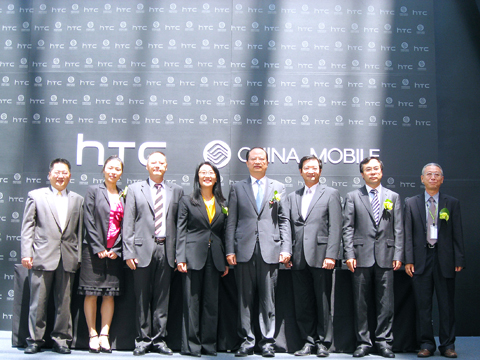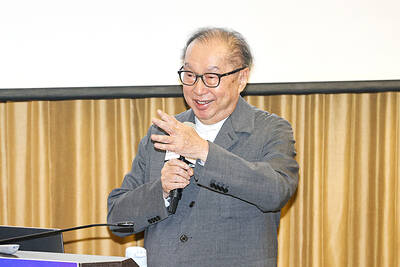China Mobile Ltd (中國移動), the world’s biggest telecommunications operator by subscribers, and Taiwan’s HTC Corp (宏達電) signed a memorandum of understanding in Taoyuan yesterday to establish a long-term alliance in Time Division Synchronous Code Division Multiple Access (TD-SCDMA) research and development, associated product development and market research.
TD-SCDMA is the first patented third generation (3G) data-centric mobile technology developed by the People’s Republic of China (PRC) that is not dependent on Western technology.
China Mobile’s heavy TD-SCDMA promotion requires collaboration with many international cellphone makers to create mobile handsets catering to this new telcoms trend.

PHOTO: CNA
“As the world migrates from 2G to 3G technology, we aim to introduce more than 200 TD-SCDMA products for Chinese customers as opposed to the current 50 models out on the market. Also, countries such as Japan and [South] Korea have expressed interest to learn and adopt our mobile innovations,” China Mobile chairman and chief executive officer Wang Jianzhou (王建宙) said at the signing ceremony yesterday.
China Mobile’s other existing mobile vendor partners include Samsung Electronics Co, LG Electronics Inc, Lenovo Group Ltd(聯想), Huawei Technologies Co’s (華為科技) and ZTE Telecommunication Equipment Co (中興通訊), Wang told reporters. The company is also in talks with Nokia Corp.
The PRC operator intends to invest more than 47 million yuan (US$6.88 million) in its strategic alliance with HTC, and aside from its focus on TD-SCDMA, the two will also study the next Western mobile telecommunications technology, Long Term Evolution (LTE), to spread its bets on the future worldwide standard.
At the same event yesterday, HTC chairwoman Cher Wang (王雪紅) said she was enthusiastic about the TD-SCDMA technology and told media that “since 2008, HTC has already launched one TD-SCDMA phone in China, which met with much success.”
“We promise to offer China Mobile our best design and best quality TD-SCDMA mobile handsets. In fact, chairman Wang has already been to our creativity lab and seen the next cellphone to be launched later this year as well as two others scheduled for next year,” Cher Wang said.
“Our LTE technology development with China Mobile will primarily emphasize research, rather than commercialization. But our TD-SCDMA products will definitely incorporate the China Mobile user interface and its wide variety of widgets,” HTC chief executive officer Peter Chou (周永明) said.
So far, China Mobile has sold more than 1 million 3G phones. Chairman Wang said that in order for TD-SCDMA phones to become mainstream in China, they would have to become more affordable, settling in the 1,000 yuan price range, as it gains new subscribers, and existing customers retire their old cellphones to embrace newer technology.

BYPASSING CHINA TARIFFS: In the first five months of this year, Foxconn sent US$4.4bn of iPhones to the US from India, compared with US$3.7bn in the whole of last year Nearly all the iPhones exported by Foxconn Technology Group (富士康科技集團) from India went to the US between March and last month, customs data showed, far above last year’s average of 50 percent and a clear sign of Apple Inc’s efforts to bypass high US tariffs imposed on China. The numbers, being reported by Reuters for the first time, show that Apple has realigned its India exports to almost exclusively serve the US market, when previously the devices were more widely distributed to nations including the Netherlands and the Czech Republic. During March to last month, Foxconn, known as Hon Hai Precision Industry

Taiwan Semiconductor Manufacturing Co (TSMC, 台積電) and the University of Tokyo (UTokyo) yesterday announced the launch of the TSMC-UTokyo Lab to promote advanced semiconductor research, education and talent development. The lab is TSMC’s first laboratory collaboration with a university outside Taiwan, the company said in a statement. The lab would leverage “the extensive knowledge, experience, and creativity” of both institutions, the company said. It is located in the Asano Section of UTokyo’s Hongo, Tokyo, campus and would be managed by UTokyo faculty, guided by directors from UTokyo and TSMC, the company said. TSMC began working with UTokyo in 2019, resulting in 21 research projects,

Ashton Hall’s morning routine involves dunking his head in iced Saratoga Spring Water. For the company that sells the bottled water — Hall’s brand of choice for drinking, brushing his teeth and submerging himself — that is fantastic news. “We’re so thankful to this incredible fitness influencer called Ashton Hall,” Saratoga owner Primo Brands Corp’s CEO Robbert Rietbroek said on an earnings call after Hall’s morning routine video went viral. “He really helped put our brand on the map.” Primo Brands, which was not affiliated with Hall when he made his video, is among the increasing number of companies benefiting from influencer

Quanta Computer Inc (廣達) chairman Barry Lam (林百里) yesterday expressed a downbeat view about the prospects of humanoid robots, given high manufacturing costs and a lack of target customers. Despite rising demand and high expectations for humanoid robots, high research-and-development costs and uncertain profitability remain major concerns, Lam told reporters following the company’s annual shareholders’ meeting in Taoyuan. “Since it seems a bit unworthy to use such high-cost robots to do household chores, I believe robots designed for specific purposes would be more valuable and present a better business opportunity,” Lam said Instead of investing in humanoid robots, Quanta has opted to invest